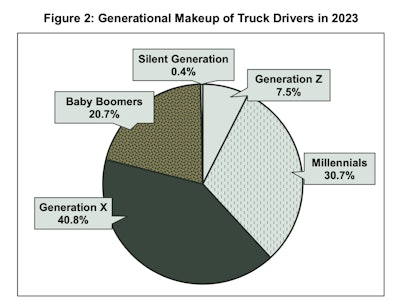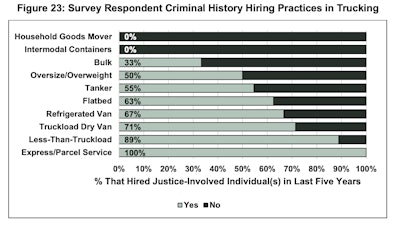The U.S. truck driver workforce is facing an aging workforce, persistent gender and racial imbalances, and growing difficulty in attracting younger drivers, according to a report by the American Transportation Research Institute.
The report sourced data from 12 years of ATRI surveys, Owner-Operator Independent Drivers Association Foundation membership data, Bureau of Labor Statistics records, and a 2024 ATRI poll of 1,242 drivers. It examined the shifting demographic of truck drivers, its implications for the industry, and offered hiring strategies recommendations for fleets.
ATRI stressed that understanding demographic shifts is key to developing more effective recruitment strategies and reducing long-haul turnover, which currently averages 94%.
Aging workforce, decline in younger drivers
ATRI highlighted that the average age of truck drivers has increased from 42 in 1995 to 47 last year, with retirements accelerating and a shortage of younger entrants.

Generation X, born between 1965 and 1980, represents 40.8% of the truck driver workforce, while Baby Boomers, born between 1946 and 1964, still account for 20.7%. As these generations leave the industry, the need to bring in younger talent becomes urgent.
Millennials (1981-1995) make up 30.7% of truck drivers —significantly below their representation in the overall labor force. Gen Z (1996-2010) represents just 7.5% of the driver pool, even though they’re a growing segment of working-age adults.
ATRI attributes part of the gap to legal and insurance hurdles. Federal regulations under most cases prohibit drivers under 21 from operating across state lines, cutting off early entry opportunities for high school graduates. In addition, many insurers either reject or heavily surcharge drivers under 25, making them less attractive to employers.
Another factor to recruiting younger drivers is the declining rate of early licensure. Fewer teens are getting their driver’s licenses. In 2023, 75% of 16-year-olds did not hold a license, up from 69% in the early 2000s, reflecting broader generational shifts in mobility.
The study points to potential recruitment opportunities among Millennials and Gen Z, especially through highlighting long-term earning potential, early training programs, mentorship opportunities, and pathways from other transportation jobs, such as warehouse and logistics staff.
Women remain underrepresented, racial diversity improves
While women make up 47.1% of the labor force, they represent just 4.1% of truck drivers in 2024. Additionally, only 37% of female CDL holders have a Class A license, required for long-haul driving.
The report recommends targeting women in adjacent roles, such as non-driving trucking positions; recruiting women with Class B and C CDLs; adopting policies that support work-life balance for women entering the field later in life or caring for dependents; and addressing facility and safety concerns by improving access to safe truck stop facilities.
Meanwhile, racial diversity within the industry has improved over the past decade. People of color now account for 37% of truck drivers, compared to 38% of the broader workforce. Between 2014 and 2023, the share of White drivers fell from 77% to 63%, while Black and Hispanic representation rose to 23% each, and Asian drivers increased to 4%.
Opportunities for underrepresented groups
ATRI suggested carriers need to widen recruitment strategies to include a younger more diverse population, including underrepresented groups such as former foster youth and justice-involved individuals.

Among 100 motor carriers that ATRI polled, 57% hired at least one person with a criminal record from the past five years.
For individuals with criminal records, ATRI suggests expanding CDL training programs through partnerships with correctional facilities and nonprofit organizations. Training offered before or immediately after release can ease the transition into the workforce.
Offering reentry support like housing referrals or flexible scheduling to meet parole requirements can improve job retention and remove barriers to rejoining the workforce.
ATRI also highlighted foster youth as a disregarded demographic of talent. Organizations like Foster Care to Success are working closely to offer access to opportunities in the industry by providing scholarships, mentorship, and career guidance.
ATRI recommends hosting job fairs tailored specifically to foster youth, which should have on-the-spot interviews, paid CDL training, and guaranteed job placement to help close the gap between interest and access.














